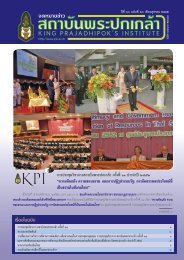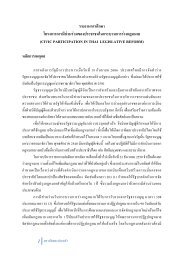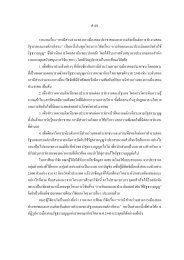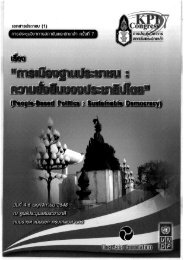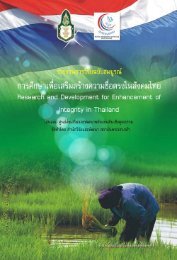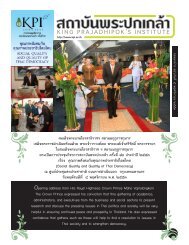SUFFiciENcy EcONOMy ANd GRASSROOtS DEvElOPMENt
SUFFiciENcy EcONOMy ANd GRASSROOtS DEvElOPMENt
SUFFiciENcy EcONOMy ANd GRASSROOtS DEvElOPMENt
You also want an ePaper? Increase the reach of your titles
YUMPU automatically turns print PDFs into web optimized ePapers that Google loves.
200<br />
The Meaning of Sufficiency Economy <br />
International Conference<br />
The second Inpaeng mission was to promote community entrepreneurship.<br />
Given that food security had been established, generally, forest-like plantations<br />
provided more than the family annual consumption. Food preservation and<br />
transformation were required to manage the excess. Marketing and financial<br />
management of the product should be implemented through community<br />
entrepreneurs. Local milling groups, organic fertiliser production, herbal medicine<br />
manufacturing and wild berry juice production were examples of the community<br />
entrepreneurship demonstrated through the Inpaengcentre.<br />
The third mission was to establish the community welfare system. To promote<br />
community welfare, saving or microfinance groups have been formed. Members of<br />
the saving group don’t need collateral to borrow money. The interest gained from<br />
lending is used for member’s benefits such as money for hospital admission and<br />
funeral funds. <br />
It is evident that these three missions were interconnected. When families<br />
established their food security, they were more likely to have excess production (first<br />
mission). The knowledge and technology were required to preserve, transform and<br />
manage excess production (second mission). Finally, a system was required for<br />
distributing the products to the market, for managing financial business and for<br />
strengthening community welfare (third mission).<br />
In conclusion, the Inpaeng network promotes self-reliance and sustainable<br />
integrated agricultural production, and in food security. Spiritually it promotes<br />
moderation, thoughtfulness/consideration, encourages ecological-friendliness and<br />
morality. <br />
<br />
The Social capital of the Inpaeng network<br />
The relationship between social capital and health can be reviewed from many<br />
studies(Kawachi et al. 1996; Kawachi et al. 1997; Kennedy et al. 1998). In recent<br />
years, concepts of social capital have been studied for the benefit of health<br />
promotion. Social capital can be defined as characteristics that reflect the<br />
connectedness of community members and neighborhood. These characteristics<br />
include social network, social norms, social engagement, social cohesion and trust<br />
(Kawachi and Kennedy 1997; Putnam 1995). Social capital can be inferred to all<br />
forms of social aggregation, bounding and bridging for the purpose of its members’<br />
mutual benefit(Baum and Ziersch 2003). Social capital can be considered as a<br />
determinant of health and well being. Putnam argues that people who live in high<br />
social capital communities have lower risk for premature death and many major<br />
diseases including cancer and heart attacks compared to those who live in low-social<br />
capital communities(Putnam 2000). In the field of oral health, Watt suggests that<br />
social capital should be an important framework for oral health promotion(Watt<br />
2002). Some research shows the studies of social capital and oral health or oral<br />
health-related issues(Gilbert et al. 2003; Holtgrave and Crosby 2006).



